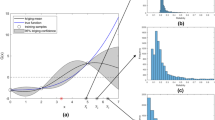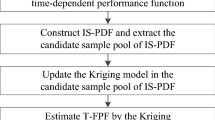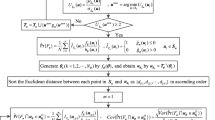Abstract
Inverse reliability analysis evaluates a percentile value of a performance function when the target reliability is given. In cases of high dimensional or highly nonlinear performance functions, sampling-based methods such as Monte Carlo simulation (MCS), Latin hypercube sampling, and importance sampling are considered to be better candidates for reliability analysis. The sampling-based methods are very accurate but require a large number of samples, which can be very time-consuming. Therefore, this paper proposes an efficient and/or accurate sampling-based reliability analysis method without using a surrogate model. The proposed method helps to improve the accuracy of reliability analysis with the same number of samples or to ensure the same accuracy of reliability analysis with fewer samples. This study starts with an idea of training relationship between limited samples constituting realization of the performance distribution—usually between 10 and 100—and its corresponding true percentile value where the performance distribution is defined as a one-dimensional distribution resulted from a performance function and its random variables. To this end, feedforward neural network (FNN), which is one of promising artificial neural network (ANN) models that approximate high dimensional models using layered structures, is introduced in this study, and limited samples constituting realizations of various performance distributions and their corresponding true percentile values are used as input and target data, respectively. Various beta distributions are used to create the training data sets. A FNN training method using kernel density estimation and equidistant points to represent the kernel distribution data is also proposed to remove dimensionality of the training inputs. Comparative study shows that the proposed method training FNN with samples constituting realization of the performance distribution (Method 2) is more accurate than a method that directly estimates the percentile value from the kernel distribution fitting the samples constituting realization generated through MCS (Method 1). In addition, compared to Method 2, another proposed method that trains FNN with the kernel density estimation and equidistant points (Method 3) is more accurate in reliability analysis and more computationally efficient in FNN training. Method 3 is also applicable to high reliability problems, and it is more accurate than Kriging-based method for high dimensional problems.














Similar content being viewed by others
References
Acar E, Haftka RT (2007) Reliability-based aircraft structural design pays, even with limited statistical data. J Aircr 44(3):812–823
Allen M, Maute K (2004) Reliability-based design optimization of aeroelastic structures. Struct Multidisc Optim 27:228–242
Altair (2017) Altair HyperStudy tutorials. https://www.altairhyperworks.com. Accessed 17 Oct 2020.
Amouzgar K, Strömberg N (2017) Radial basis functions as surrogate models with a priori bias in comparison with a posteriori bias. Struct Multidisc Optim 55:1453–1469
Bhattacharjee P, Ramesh Kumar K, Janardhan Reddy TA (2012) Reliability design optimization for aerospace product an integrated approach. Int J Syst Assur Eng Manag 3(2):153–159
Bichon BJ, McFarland JM, Mahadevan S (2011) Efficient surrogate models for reliability analysis of systems with multiple failure modes. Reliab Eng Syst Saf 96(10):1386–1395
Breitung K (1984) Asymptotic approximations for multinormal integrals. J Eng Mech 110(3):357–366
Cheng J, Li QS (2008) Reliability analysis of structures using artificial neural network based genetic algorithms. Comput Methods Appl Mech Eng 197(45–48):3742–3750
Choi M, Cho H, Choi K, Cho S (2015) Sampling-based RBDO of ship hull structures considering thermo-elasto-plastic residual deformation. Mech Based Des Struct Mach 43(2):183–208
Demirocak DE, Bhushan B (2015) Probing the aging effects on nanomechanical properties of a LiFePO4 cathode in a large format prismatic cell. J Power Sources 280:256–262
Denny M (2001) Introduction to importance sampling in rare-event simulations. Eur J Phys 22:403–411
Du X, Sudjianto A, Chen W (2004) An integrated framework for optimization under uncertainty using inverse reliability strategy. J Mech Des 124:562–570
Elhewy AH, Mesbahi E, Pu Y (2006) Reliability analysis of structures using neural network method. Probab Eng Mech 21:44–53
Ferreiro-Cabello J, Fraile-Garcia E, Ascacibar EMD, Martinez-de-Pison FJ (2018) Metamodel-based design optimization of structural one-way slabs based on deep learning neural networks to reduce environmental impact. Eng Struct 155:91–101
Frangopol DM, Maute K (2003) Life-cycle reliability-based optimization of civil and aerospace structures. Comput Struct 81(7):397–410
Gomes WJDS (2020) Shallow and deep artificial neural networks for structural reliability analysis. ASCE-ASME J Risk Uncertain Eng Syst Part B 6(4):041006
Grujicic M, Arakere G, Bell W, Marvi H, Yalavarthy H, Pandurangan B, Haque I, Fadel G (2010) Reliability-based design optimization for durability of ground vehicle suspension system components. J Mater Eng Perform 19:301–313
Hu Z, Du X (2015) First order reliability method for time-variant problems using series expansions. Struct Multidisc Optim 51:1–21
Hu Z, Mahadevan S (2016) Global sensitivity analysis-enhanced surrogate (GSAS) modeling for reliability analysis. Struct Multidisc Optim 53(3):501–521
Hu Z, Mahadevan S (2017) A surrogate modeling approach for reliability analysis of a multidisciplinary system with spatio–temporal output. Struct Multidisc Optim 56(3):553–569
Jayalakshmi T, Santhakumaran A (2011) Statistical normalization and back propagation for classification. Int J Comput Theory Eng 3(1):89–93
Lee I, Choi KK, Du L, Gorsich D (2008) Inverse analysis method using MPP-based dimension reduction for reliability-based design optimization of nonlinear and multi-dimensional systems. Comput Methods Appl Mech Engrg 198(1):14–27
Lee I, Choi KK, Zhao L (2011) Sampling-based RBDO using the stochastic sensitivity analysis and dynamic Kriging method. Struct Multidisc Optim 44(3):299–317
Lee U, Kang N, Lee I (2019) Selection of optimal target reliability in RBDO through reliability-based design for market systems (RBDMS) and application to electric vehicle design. Struct Multidisc Optim 60:949–963
Lee U, Kang N, Lee I (2020) Shared autonomous electric vehicle design and operations under uncertainties: A reliability-based design optimization approach. Struct Multidisc Optim 61:1529–1545
Lehký D, Novák D (2012) Solving inverse structural reliability problem using artificial neural networks and small-sample simulation. Adv Struct Eng 15(11):1911–1920
Li G, Li B, Hu H (2018) A novel first–order reliability method based on performance measure approach for highly nonlinear problems. Struct Multidisc Optim 57:1593–1610
Li X, Gong C, Gu L, Jing Z, Fang H, Gao R (2019) A reliability-based optimization method using sequential surrogate model and Monte Carlo simulation. Struct Multidisc Optim 59:439–460
Li M, Wang Z (2020) Deep learning for high-dimensional reliability analysis. Mech Syst Sig Process 139:106399
Mahadevan S, Smith N (2006) Efficient first-order reliability analysis of multidisciplinary systems. Int J Reliab Saf 1:137–154
Naess A, Leira BJ, Batsevych O (2009) System reliability analysis by enhanced Monte Carlo simulation. Struct Saf 31(5):349–355
Nam T, Mavris DN (2018) Multistage reliability-based design optimization and application to aircraft conceptual design. J Aircr 55(2):2022–2036
Nezhad HB, Miri M, Ghasemi MR (2019) New neural network-based response surface method for reliability analysis of structures. Neural Comput Appl 31(3):777–791
Oh S, Jung Y, Kim S, Lee I, Kang N (2019) Deep generative design: Integration of topology optimization and generative models. J Mech Des 141(11):111405
Ojha VK, Abraham A, Snášel V (2017) Metaheuristic design of feedforward neural networks: a review of two decades of research. Eng Appl Artif Intell 60:97–116
Olsson G, Sandberg A, Dahlblom O (2003) On latin hypercube sampling for structural reliability analysis. Struct Saf 25(1):47–68
Pan Q, Dias D (2017) An efficient reliability method combining adaptive support vector machine and Monte Carlo simulation. Struct Saf 67:85–95
Roy A, Manna R, Chakraborty S (2019) Support vector regression based metamodeling for structural reliability analysis. Probab Eng Mech 55:78–89
Song H, Choi KK, Lee CI, Zhao L, Lamb D (2013) Adaptive virtual support vector machine for reliability analysis of high-dimensional problems. Struct Multidisc Optim 47:479–491
Thaller LH (1983) Expected cycle life vs depth of discharge relationships of well-behaved single cells and cell strings. J Electrochem Soc 130(5):986–990
Xiang Z, Chen J, Bao Y, Li H (2020) An active learning method combining deep neural network and weighted sampling for structural reliability analysis. Mech Syst Signal Process 140:106684
Yang X, Mi C, Deng D, Liu Y (2019) A system reliability analysis method combining active learning Kriging model with adaptive size of candidate points. Struct Multidisc Optim 60:137–150
Yoo D, Lee I, Cho H (2014) Probabilistic sensitivity analysis for novel second-order reliability method using generalized chi-squared distribution. Struct Multidisc Optim 50(5):787–797
Youn BD, Choi KK (2004) A new response surface methodology for reliability-based design optimization. Comput Struct 82(2–3):241–256
Youn BD, Choi KK, Yang RJ, Gu L (2004) Reliability-based design optimization for crashworthiness of side vehicle impact. Struct Multidisc Optim 26:272–283
Yu Y, Hur T, Jung J, Jang IG (2019) Deep learning for determining a near-optimal topological design without any iteration. Struct Multidisc Optim 59(3):787–799
Zhang J, Du X (2010) A second-order reliability method with first-order efficiency. J Mech Des 132(10):101006
Zhao L, Choi KK, Lee I (2011) Metamodeling method using dynamic Kriging for design optimization. AIAA J 49(9):2034–2046
Zhu P, Shi L, Yang RJ, Lin SP (2015) A new sampling-based RBDO method via score function with reweighting scheme and application to vehicle designs. Appl Math Model 39:4243–4256
Zhu Z, Du X (2016) Reliability analysis with Monte Carlo simulation and dependent Kriging predictions. J Mech Des 138:121403–121411
Acknowledgements
This research was supported by the KAIST-funded Global Singularity Research Program for 2021 (N11210060).
Author information
Authors and Affiliations
Corresponding author
Ethics declarations
Conflict of interest
The authors declare that they have no conflict of interest.
Replication of results
The code for this paper is available at the website: (https://drive.google.com/drive/folders/1nEi6r3YvSJrOvgkZnNDBcUWLR9nI33OH?usp=sharing).
Additional information
Responsible Editor: Pingfeng Wang
Publisher's Note
Springer Nature remains neutral with regard to jurisdictional claims in published maps and institutional affiliations.
Appendices
Appendix A: Determining the range of shape parameters of beta distributions
This section shows how the range of shape parameters of beta distributions is determined. For several ranges of shape parameters, validation for performance distributions generated from various performance functions and random variables is conducted using FNN trained with 20,000 training data sets generated from each range of shape parameters. To this end, various performance functions are created through the polynomial functions given by
where the coefficients A, B, C, and D are randomly drawn from \([ - 10,10]\), and the exponents p1, p2, p3, and p4 are integers randomly drawn from \([ - 10,10]\). It is assumed that \(X_{1} \sim N(\mu_{{X_{1} }} ,\sigma_{{X_{1} }} )\) and \(X_{2} \sim N(\mu_{{X_{2} }} ,\sigma_{{X_{2} }} )\) where each distribution parameter is randomly drawn from \([0,10]\). For 1,000 validation sets of performance distributions, normalized true percentile values for 95% reliability are predicted using Method 3 with 100 samples (i.e., n = 100) and the NRMSE results according to range of shape parameters are given in Fig. 15 in Appendix. The range of \([0,20]\) shows the NRMSE that converges to the smallest value, and therefore, the range is used in this study because it is verified that sufficiently diverse beta distributions can be generated.
Appendix B: Application on a bimodal performance distribution case
This section shows whether percentile value estimation using the proposed reliability analysis framework is applicable for bimodal performance distributions. To estimate the percentile value of the bimodal performance distribution, training data sets are created by generating bimodal distributions. After generating two beta distributions from Eq. (5), a bimodal distribution can be generated by combining the two beta distributions into one bimodal distribution through kernel density estimation. In this way, bimodal distributions with various characteristics can be generated, and training data sets can be created with these distributions as shown in Sect. 2.3. Validation for various bimodal distributions generated by mixing the distributions of two random variables, which are used in Appendix A, through kernel density estimation is conducted using FNN trained with 20,000 training data sets. For 1,000 validation sets of bimodal distributions, normalized true percentile values for 95% reliability are predicted with 100 samples (i.e., n = 100). The NRMSEs of Methods 1 and 3 are 0.0957 and 0.0857, respectively. The NRMSE of Method 3 is improved by 10.4% compared to that of Method 1, and 25 more samples are required for Method 1 to have the same accuracy as Method 3. This verifies that the proposed reliability analysis framework can also be applied to bimodal performance distributions.
Rights and permissions
About this article
Cite this article
Lee, U., Lee, I. Efficient sampling-based inverse reliability analysis combining Monte Carlo simulation (MCS) and feedforward neural network (FNN). Struct Multidisc Optim 65, 8 (2022). https://doi.org/10.1007/s00158-021-03144-2
Received:
Revised:
Accepted:
Published:
DOI: https://doi.org/10.1007/s00158-021-03144-2





